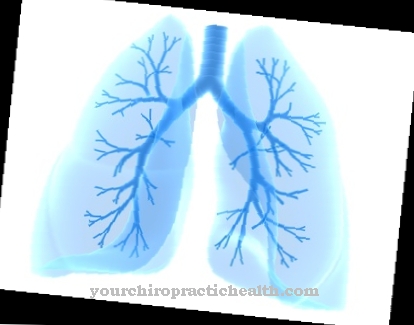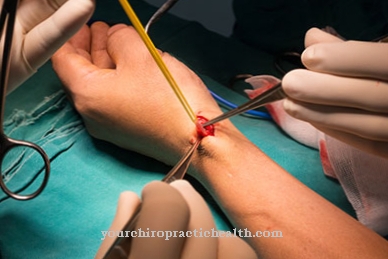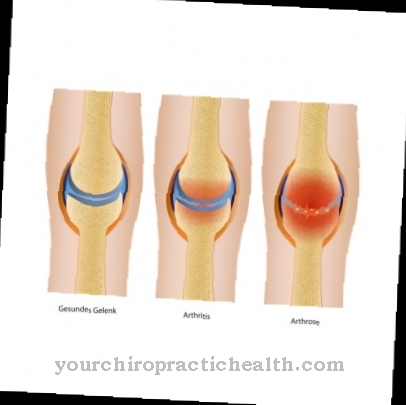A Heart defect or Cardiac vitium is a general term for disorders of the structure and structure of the heart. Heart defects are divided into acquired heart defects (e.g. due to infections or heart diseases) and congenital heart defects. Congenital heart defects are usually heart malformations that can be discovered and treated in the womb or in the newborn. Nevertheless, heart defects can usually be treated for a lifetime.
What is a heart defect?

© p6m5 - stock.adobe.com
The word heart defect is the generic term for both congenital malformations of the heart and for congenital or acquired Valvular heart disease. In addition, the congenital heart defects are divided into acynotic or cyanotic heart defects. Cyanosis is the blue-red discoloration of the skin and mucous membranes as a result of a decrease in the oxygen content in the blood (central cyanosis).
The most common acynotic heart defect is pulmonary stenosis and second place is shared by aortic valve stenosis (constrictions) and coarctation of the aorta. Malformations of the aortic arch are rare. The primary acynotic heart defects include defects of the atrial and / or ventricular septus and the ductus arteriosus apertus.
The primary cyanotic heart defects include the Fallot tetralogy, hypoplasia of the right or left ventricles, pulmonary vein malnutrition and the like. a. The frequency of congenital heart defects is 6-10 newborns for every 1000 live births.
causes
Embryonic heart and vascular development takes place between the 14th and 60th day of pregnancy. During this development phase, the cardiovascular system reacts sensitively to external and genetic factors. Often certain exogenous, i.e. external, influences create certain ones Heart defect. Excessive alcohol consumption during pregnancy often leads to septal defects and Fallot’s tetralogy (pulmonary stenosis, atrial septal defect, right heart hypertrophy and displaced aorta).
The administration of medication during pregnancy should always be considered, as numerous heart defects can also arise. Certain anti-epileptic drugs can cause pulmonary and / or aortic stenosis. If the mother has certain diseases during pregnancy - such as diabetes mellitus - there is an increased risk of ventricular septal defects, v. a. when the metabolism is poor.
Some infectious diseases during pregnancy are also dangerous and can cause a heart defect - for example rubella embryopathy, which can lead to a persistent ductus arteriosus.
Heart defects occur more frequently in certain genetic syndromes and chromosome maldistribution (internal or endogenous factor). Ventricular and / or atrial septal defects of varying severity are typical in trisomy 21 or Down syndrome. In Marfan's syndrome, mitral and tricuspid valve prolapse or aortic dilation occurs because there is a substance defect in the connective tissue.
Acquired heart defects occur in the course of life. Infectious inflammation usually leads to valve defects, most of which have to be corrected surgically. Degenerative valve changes occur more frequently, which can be observed for the time being and operated on from a certain degree of severity.
Symptoms, ailments & signs
A heart defect often causes the heart to slow down. As a result, the person concerned is physically less productive and exhausted more quickly under stress. Breathing difficulties and cardiac arrhythmias are also typical, and these also increase as the disease progresses.
The symptoms also include fluctuations in blood pressure and circulatory disorders. Thrombosis can develop as a result of increased blood clotting. In the worst case, a stroke or heart attack occurs. The general symptoms initially only occur during physical activity and persist in the advanced stage.
In general, the symptoms of a heart defect are similar to those of heart failure. Accordingly, water retention, fatigue and a racing heart can occur. Depending on its cause, a heart defect can cause numerous other symptoms and complaints. If, for example, what is known as mitral stenosis is the cause, a bloody cough and increasing chest pain occur. Outwardly, bluish lips and bluish-red cheeks can often be noticed.
If the heart defect is an aortic stenosis, reduced blood flow to the heart muscle can occur. This manifests itself among other things by dizziness, brief fainting attacks and the typical symptoms of angina pectoris. The signs of a congenital heart defect can appear in the first few years of life and develop slowly. Some people have no symptoms whatsoever.
Complications
Heart defects can lead to various complications. In the case of congenital heart defects, there is a fundamental risk of heart muscle weakness and an insufficient supply of oxygen to the organs. Depending on the type and severity of the heart defect, various heart problems can arise in the course of life. This can lead to arrhythmias and pain, but also to severe organ damage or heart attacks.
The increased production of red blood cells can also cause the blood to thicken. This increases the risk of strokes, vascular thrombosis and heart attacks. If a congenital heart defect is not treated, it can also lead to severe inflammation, cardiac arrhythmias or diseases of the heart valves. Sometimes permanent lung damage and diseases of the internal organs also occur.
Heart defects that develop as a result of inflammation, stress, or excessive drug use can cause a number of other complications, depending on the cause. Surgical treatment for a heart valve defect can also lead to complications.
The heart-lung machine can change blood clotting, temporarily cause renal insufficiency and sometimes even lead to life-threatening blood blockages. After the procedure, bleeding and infection can occur, but also temporary psychological complications.
When should you go to the doctor?
People who experience frequent tiredness and fatigue for no apparent reason should consult a doctor. This is especially true if the discomfort increases over time. A gradual decrease in performance, often associated with shortness of breath and weakness, indicates an acquired heart defect.
A medical professional must clarify the symptoms and, if necessary, initiate therapy directly to reduce the risk of serious complications. If signs of mitral stenosis become noticeable, a doctor should be consulted immediately.
A bloody cough and external signs such as bluish lips and bluish-red cheeks, in particular, require examination. You must also see a doctor if you have water retention and other unusual complaints that cannot be traced back to a specific cause. A congenital heart defect also requires immediate clarification as soon as the first symptoms are noticed.
Arrhythmias, pain and cramps should be examined immediately. If there is a heart attack, the emergency services must be called. First aid measures are also to be provided. A diagnosed heart defect requires close monitoring by a cardiologist.
Doctors & therapists in your area
Treatment & Therapy
The treatment of congenital or acquired heart defects requires lifelong special cardiological care. Despite the necessary surgical corrections, there are mostly residual and subsequent conditions.
These usually occur after heart defects were corrected in early childhood.This cardiac surgery distinguishes between palliative and corrective operations to remove heart defects.
Corrective surgery is intended to restore normal functioning. This can normalize life expectancy. Palliative operations for heart defects are performed when there are serious abnormalities.
However, this also includes heart or heart-lung transplants. Today valve surgeries are the most common. Biological valves (from pigs, cattle or horses) or mechanical artificial prostheses are used.
Outlook & forecast
The prognoses for a heart defect are very different, because the severity of the heart defect has to be taken into account. In addition, the time of diagnosis also plays a major role. The earlier the heart defect is detected, the better the chances of a complete and quick healing.
The ever advancing medical technology meanwhile offers very good chances that newborns with a heart defect will reach adulthood. In general, a congenital heart defect is considered a chronic disease. However, those who seek medical and drug treatment at an early stage can positively influence their outlook and prognosis. The quality of life can thereby be maintained.
Anyone who decides against permanent treatment can expect serious complications. You may experience severe chest pain and febrile convulsions. In the worst case, cardiac arrest threatens. If no life-saving measures are taken, death occurs.
prevention
An important preventive measure for corrected or existing congenital or acquired heart defects is endocarditis prophylaxis in interventions with a possible risk of infection, e.g. B. in dental procedures. This can prevent inflammation and the following defects in the heart valves, v. a. with pre-existing heart defects.
Every patient with heart defects should always have a heart card with them and present it at every visit to the doctor. You should also refrain from consuming alcohol during pregnancy and ensure that you have a sufficient vaccination status before the start of pregnancy in order to avoid heart defects in the newborn child.
Aftercare
Anyone who suffers from a heart defect should not take this lightly. Appropriate follow-up care is essential. Otherwise there is a risk of serious complications and, in the worst case, even death. Affected people should have an existing heart defect regularly monitored by a specialist.
Such check-ups can identify potential dangers early on. Various measures can then be taken to eliminate possible dangers or complications. Those who do without regular visits and check-ups are putting themselves at great risk.
An unexpected heart attack or stopping your heartbeat are just two of the many consequences that can occur in such a case. A deterioration in the condition cannot be recognized without appropriate follow-up care. Anyone who suffers from a congenital or a sudden heart defect must not neglect appropriate follow-up care under any circumstances.
The heart is our most important and central organ, without which the human body cannot survive. Follow-up care for an existing heart defect is all the more important.
You can do that yourself
People who suffer from a heart defect do not necessarily have to limit themselves in everyday life. However, depending on the nature of the discomfort, a few things should be observed to avoid complications.
First of all, with regard to the type of heart defect, it is important to work with the doctor to create an individual therapy that includes physical exercise, dietary measures and medical treatment. The diet should be composed in such a way that the heart is not additionally stressed.
A healthy diet high in fiber and polyunsaturated fat is recommended. A lot of sugar, white flour and animal fat should be avoided. Those affected should also refrain from smoking and only enjoy other luxury foods such as coffee or alcohol in moderation.
In addition, those with heart disease benefit from individually tailored exercise training and regular stress relief. For example, exercises from yoga and breathing exercises are recommended. If necessary, a physiotherapist or an occupational therapist can be called in.
Help from other people - for example in a self-help group - can also be useful in order to accept the disease and to learn new strategies for better handling the heart defect. In addition, close medical supervision is of course always indicated. The diseased heart must be examined regularly, especially if there are unusual symptoms or complaints.
























.jpg)



